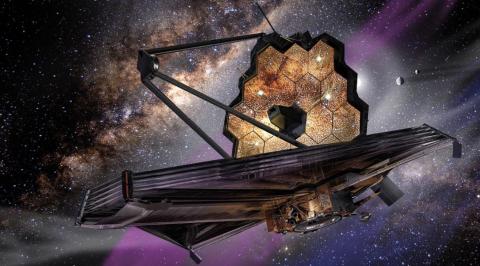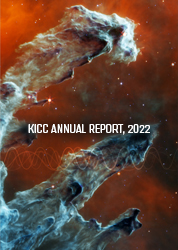
Submitted by Matthew Bothwell on Fri, 01/03/2024 - 09:39
Scientists at Kavli Institute for Cosmology, Cambridge (KICC), have been allocated more than 300 hours of observing time with the James Webb Space Telescope (JWST). This observing time has been awarded through four successful programmes, including a Large Programme, led by Hannah Übler, Tobias Looser, Francesco D’Eugenio and Roberto Maiolino, and involving several members of the KICC as well as a broader team of international collaborators.
These programmes are aimed at finding and characterising the first generation of stars and black holes in the early Universe, as well as their evolution and transformation across the cosmic epochs.
The four approved programmes are:
- Unveiling the nature and impact of the first population of black holes: an extensive NIRSpec-IFU survey in the first billion years. PI: Hannah Übler; Co-PI: Roberto Maiolino (137 hours)
With this Large Programme we will characterise massive black holes and their host galaxies during the first billion years of cosmic time: we will measure the masses of the galaxies and black holes, search for ongoing mergers, study AGN feedback signatures and the enrichment of the host galaxies, and look out for supernovae and Population III stars.
- OASIS: Observing All phases of StochastIc Star formation - A census of galaxies at z = 5–8 over the entire SFR–M* plane. PI: Tobias Looser; Co-PI: Francesco D’Eugenio (128 hours)
This proposal will reveal how galaxies formed stars in the early Universe, by measuring variations in the rate of star formation among early galaxies.
- Confirming Population III or a Direct Collapse Black Hole in the halo of GN-z11 at z=10.6. PI: Roberto Maiolino (48 hours)
This unique proposal will address two exciting science questions: it will measure the kinematics of gas surronding the most distant supermassive black hole known, and will characterise enigmatic emission from a region near the GN-z11 galaxy, which may be evidence of the first generation of stars in the Universe, or of even more exotic direct-collapse black holes.
- Weighting the odd: dynamics, assembly history and quenching of the oldest galaxy in the young Universe. PI: Francesco D’Eugenio; Co-PI Karl Glazebrook (Swinburne) (23 hours)
This proposal will measure the mass, chemical abundances and gas properties of ZF-UDS-7329 to understand how such a massive, old and metal rich galaxy could form and quench in the first 500 Myr after the Big Bang.
These programmes will enable scientists at KICC to continue and expand a successful research programme, developed during the past years through extensive JWST observations, aimed at understanding the origin of stars, galaxies and black holes, as well as the production of the first chemical elements.


